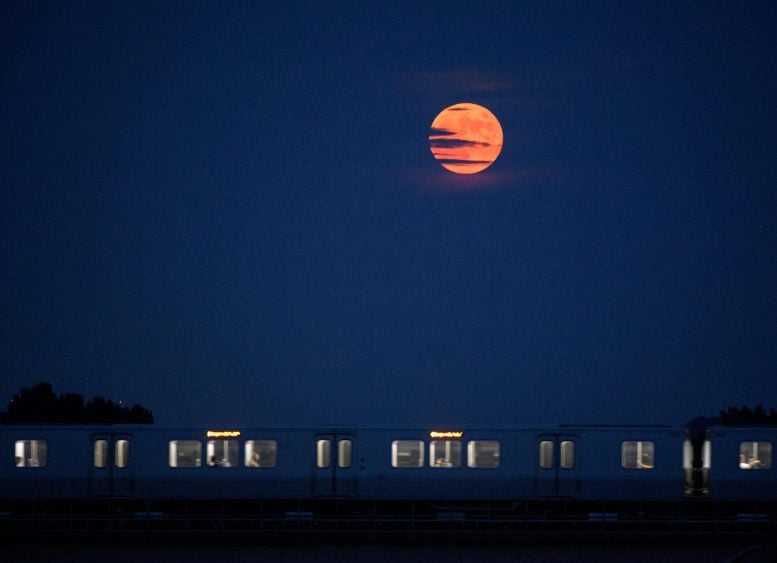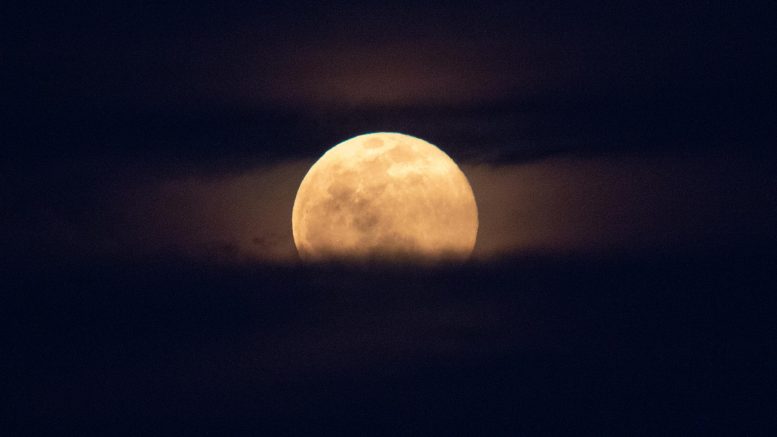
The Moon rises as a Metrorail car crosses the Potomac River in Washington D.C. on July 16, 2019 – 50 years to the day after astronauts Neil Armstrong, Michael Collins, and Buzz Aldrin launched on Apollo 11, the first mission to land astronauts on the Moon. Credit: NASA/Bill Ingalls
The Next Full Moon is the Strawberry, Mead, Honey, Rose, Flower, Hot, Hoe, or Planting Moon, Vat Purnima, Poson Poya, the LRO Moon, and a marginal Supermoon.
The next full Moon will be on Thursday afternoon, June 24, 2021, appearing opposite the Sun in Earth-based longitude at 2:40 p.m. EDT. While this will be on Thursday for much of the Earth, from India Standard Time eastward to Line Islands Time, and the International Dateline, this will be on Friday morning. The Moon will appear full for about three days around this time, from early Wednesday morning through early Saturday morning.
One Moon, Many Names
In the 1930s the Maine Farmer’s Almanac began publishing Native American names for the full Moons of the year. According to this Almanac, the Algonquin tribes of what is now the northeastern United States called this the Strawberry Moon. The name comes from the relatively short season for harvesting strawberries in the northeastern United States.
An old European name for this full Moon is the Mead Moon or Honey Moon. Mead is a drink created by fermenting honey mixed with water and sometimes with fruits, spices, grains, or hops. In some countries, mead is also called honey wine (though in others honey wine is different). Some writings suggest that the time around the end of June was when honey was ready for harvesting, which made this the “sweetest” Moon.
The word “honeymoon” traces back to at least the 1500s in Europe. The tradition of calling the first month of marriage the “honeymoon” may be tied to this full Moon because of the custom of marrying in June or because the “Honey Moon” is the “sweetest” Moon of the year.
Another European name for this full Moon is the Rose Moon. Some sources indicate the name “Rose Moon” comes from the roses that bloom this time of year. Others indicate that the name comes from the color of the full Moon this time of year.
The orbit of the Moon around the Earth is almost in the same plane as the orbit of the Earth around the Sun (only about 5 degrees off). On the summer solstice, the Sun appears highest in the sky for the year. Full Moons are opposite the Sun, so a full Moon near the summer solstice will be low in the sky. Particularly for Europe’s higher latitudes, when the full Moon is low it shines through more atmosphere, making it more likely to have a reddish color (for the same reasons that sunrises and sunsets are red). For the Washington D.C. area, on the morning of June 25, 2021, the full Moon will reach its highest for the night at 1:39 a.m. EDT, only 24.6 degrees above the southern horizon, the lowest full Moon of the year.
Other seasonal names for this full Moon that I have found mentioned in various sources (sometimes with European and sometimes with Native American origins that I have not yet been able to check up on) are the Flower Moon, Hot Moon, Hoe Moon, and Planting Moon.
For Hindus, this full Moon corresponds with Vat Purnima. During the 3 days of this full Moon, married women will show their love for their husbands by tying a ceremonial thread around a banyan tree. The celebration is based on the legend of Savitri and Satyavan.
For Buddhists, this full Moon is the Poson Poya. The Poson holiday in Sri Lanka celebrates the introduction of Buddhism in 236 BCE.
Another tribe has also given a name to this full Moon. This tribe is now scattered but mostly lived in the mid-Atlantic region of the United States. This tribe’s language is primarily English, but with a liberal smattering of acronyms, arcane scientific and engineering terms, and Hawaiian phrases (cheerfully contributed by the Deputy Project Manager). Comprised of people from all backgrounds, many of whom have gone on to join other tribes, this tribe was devoted to the study of the Moon. This tribe calls June’s full Moon the LRO Moon, in honor of the spacecraft they launched toward the Moon on June 18, 2009. The Lunar Reconnaissance Orbiter is still orbiting the Moon providing insights about our nearest neighbor in space, some of which help us understand our own planet.
Super or Not So Super?
Different publications use slightly different thresholds for deciding when a full Moon is close enough to the Earth to qualify as a supermoon. For 2021, some publications consider this full Moon the last of a series of four supermoons (from March to June). Other publications do not consider this a supermoon, as it is farther from Earth (and smaller in apparent size and brightness) than the previous three full Moons.
Full Moons, New Moons, and Calendars
In many traditional lunisolar calendars, full Moons fall in the middle of the lunar months. This full Moon is in the middle of the fifth month of the Chinese calendar, and Tammuz in the Hebrew calendar. In the Islamic calendar, the months start with the first sighting of the waxing crescent Moon shortly after the new Moon. This full Moon is near the middle of Dhu al-Qadah.
As usual, the wearing of suitably celebratory celestial attire is encouraged in honor of the full Moon.
Supermoons of 2021
The term “supermoon” was coined by the astrologer Richard Nolle in 1979 and refers to either a new or full Moon that occurs when the Moon is within 90% of perigee, its closest approach to Earth.
Supermoons have become popular over the last few decades. Depending upon how you interpret this definition, in a typical year, there can be 2 to 4 full supermoons in a row and 2 to 4 new supermoons in a row.
Since we can’t see a new Moon (except where it eclipses the Sun), what catches the public’s attention are the full supermoons, as this is when the full Moon appears near its biggest and brightest for each year.
Different publications use slightly different thresholds for deciding when a full Moon is close enough to the Earth to qualify as a supermoon.
For 2021, some publications consider the four full Moons from March to June, some the three full Moons from April to June, and some only the two full Moons in April and May as supermoons.
The full Moons in April and May were nearly tied as the closest full Moons of the year. The full Moon on May 26, 2021, was slightly closer to the Earth than the full Moon on April 26, 2021, but only by a slim 0.04%!










THE BIBLE SAYS: “THE SUN WILL TURN INTO DARKNESS, AND THE MOON INTO BLOOD, BEFORE THE GREAT AND AWESOME DAY OF THE LORD COMES” JOEL 2:31
Be not afraid…
These are traditional names for the full moons listed in the Old Farmer’s Almanac. January is Wolf Moon, Feb is Snow, March is Worm, April is Pink, May is Flower, June is Strawberry, July is Buck, August is Sturgeon, September is Corn, October is Hunter, November is Beaver, and December is Cold.
There are 13 full moons in a year so one month will get an extra and that one is the Blue Moon.
The only new term is “Supermoon” because either news sites have never heard the term ‘perigee’ or they just think SUPER will get more clicks.
Florian from 😉